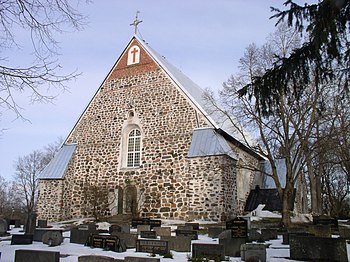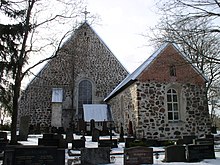Pargas Church
The Church of Pargas is a medieval stone church in Pargas (Finnish Parainen ), one in the archipelago off the southwest coast of Finland situated town. It dates from the middle of the 15th century and is used today by the Swedish- and Finnish-speaking Evangelical Lutheran parish of Pargas.
history
The parish of Pargas was probably founded in the early 13th century. The current church must therefore have had one or more wooden predecessor buildings, but these have not been proven by archaeological or historical sources. It is likely, however, that they were in the same place on a hill on the edge of the town center. The current church building was traditionally dated to the 14th century, but more recent findings indicate that the church was only built between 1440 and 1460. Alterations took place as early as the Middle Ages, and the church was expanded several times in the following centuries.
Building description
The church of Pargas has been preserved quite well in its medieval structure, even if several components have only recently been added. The original floor plan is typical of the medieval Finnish stone churches, but has been changed through several additions. The three-aisled nave of the Pargas Church is 35.7 × 19.3 meters in size, but has a relatively flat roof. The sacristy and armory , which adjoin the southern long side, were bricked up at the end of the 15th century. A church tower was originally supposed to be built on the west side , but the plan remained unfinished, so that the church of Pargas, like many medieval Finnish churches, does not have a church tower, but a free-standing bell stack . A striking structural element is the elongated Agricola chapel, which adjoins the east side of the nave. The pillars at the corners of the church date from the 17th century. There is an extension from 1765 next to the armory.
The church originally had a narrow choir on the east side , which is the exception among the medieval stone churches in Finland. The original sacristy was added to the north of the choir. For unexplained reasons, the choir was torn down again soon after its completion. The sacristy was preserved, but lost its original function. 1651–52 it was converted into the church of the Finnish-speaking community. 1689–90 the “Finnish Church” was expanded to the east. The Finnish-speaking community used this building until 1909, today it is known as the “Agricola Chapel” after the reformer Mikael Agricola and is used as a church museum.
inner space
The interior of the church of Pargas is divided into three naves by five pairs of octagonal pillars, which are covered by artistically executed cross vaults . The central nave is over three meters higher than the side aisles. The interior was decorated with Secco paintings at the end of the 15th century . These were later whitewashed and exposed again and restored in 1916. From the medieval church inventory, a crucifix made in northern Germany or Gotland at the beginning of the 15th century and nine wooden sculptures have survived. Eight of these are now kept in the National Museum of Finland.
literature
- Markus Hiekkanen: Suomen keskiajan kivikirkot (= Suomalaisen Kirjallisuuden Seuran toimituksia 1117). Suomalaisen Kirjallisuuden Seura, Helsinki 2007, ISBN 978-951-746-861-9 , pp. 126-131.
Web links
- Presentation of the church on the Pargas Community website: Swedish , Finnish
- Keskiajan Saaristomeri: Paraists kirkko (Finnish)
See also
Coordinates: 60 ° 18 ′ 4.3 ″ N , 22 ° 18 ′ 20.2 ″ E


